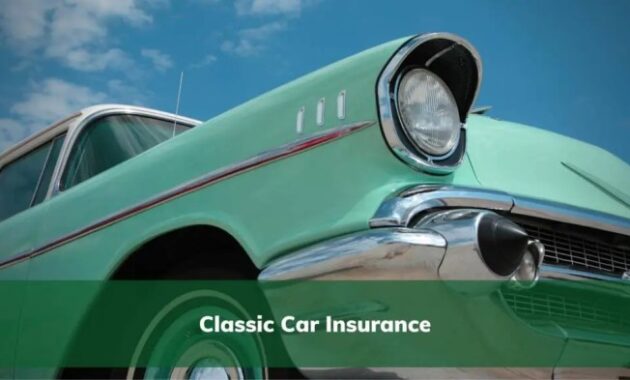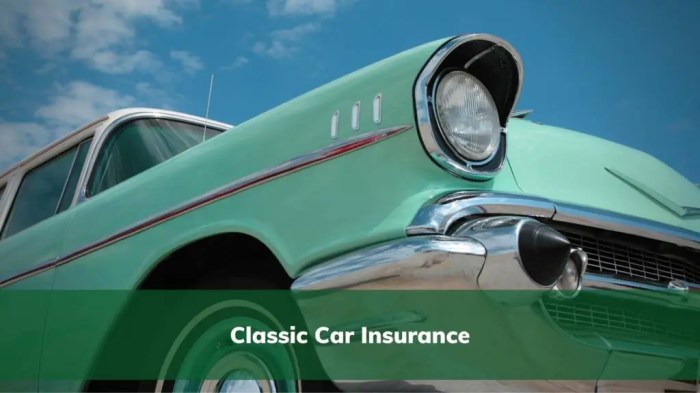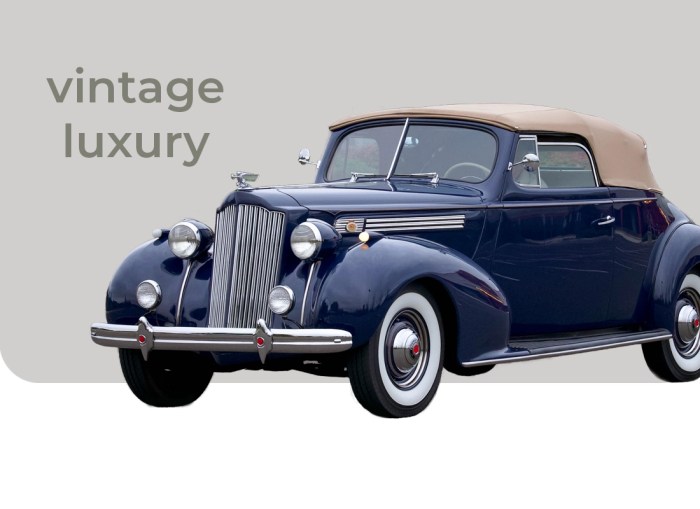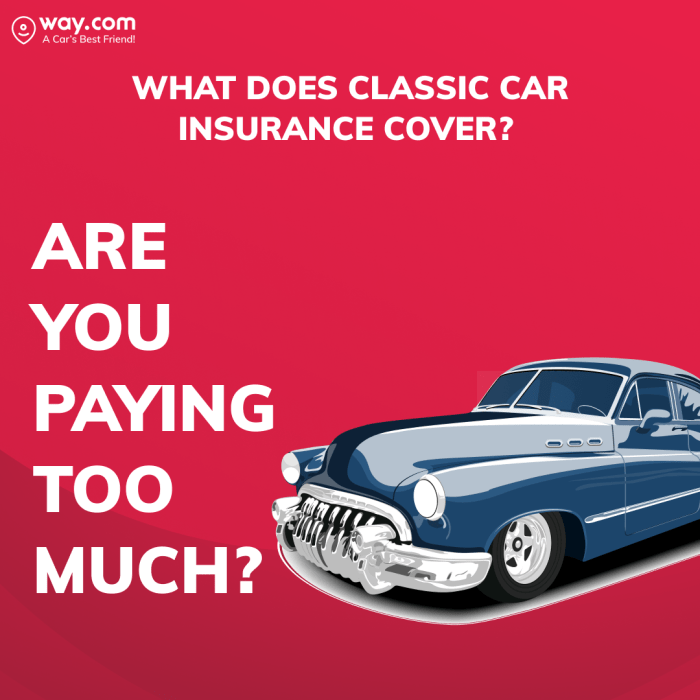
Owning a vintage car is a passion, a testament to automotive history. But insuring such a prized possession requires a specialized approach that goes beyond standard car insurance. This guide delves into the intricacies of vintage car insurance, exploring the factors that influence premiums, the coverage options available, and the process of finding the right provider to protect your classic vehicle.
From understanding the definition of a “vintage” car for insurance purposes to navigating the complexities of claims procedures, we’ll equip you with the knowledge necessary to make informed decisions and safeguard your investment. We’ll compare different coverage types, analyze premium calculations, and offer practical advice on finding reputable insurers who understand the unique needs of vintage car owners.
Defining “Vintage Car Insurance”

Vintage car insurance is a specialized type of coverage designed for vehicles that meet specific age and condition criteria, typically considered classics or antiques. Unlike standard car insurance, which focuses primarily on liability and collision coverage for everyday driving, vintage car insurance often caters to the unique needs and values of these vehicles. This includes considerations such as limited mileage, specific storage requirements, and the higher value associated with collectible cars.
Characteristics of a Vintage Vehicle for Insurance Purposes
Insurance companies use various criteria to determine whether a vehicle qualifies as “vintage.” These criteria often include the age of the vehicle (typically 25 years or older, though this can vary by insurer), its condition (well-maintained and original or restored to a high standard), its rarity and collectibility, and its historical significance. Some insurers may also consider the vehicle’s documented history and provenance. A car simply being old doesn’t automatically qualify it as vintage for insurance purposes; it must also demonstrate significant historical or collectible value.
Differences Between Classic Car Insurance and Standard Car Insurance
The key difference lies in the valuation and usage of the vehicle. Standard car insurance treats vehicles as depreciating assets, focusing on replacement cost or actual cash value at the time of an accident. Classic car insurance, on the other hand, often allows for agreed-value coverage, meaning the policy will pay out a pre-agreed sum, reflecting the vehicle’s current market value, even if it’s significantly higher than its depreciated book value. Furthermore, classic car policies frequently have lower mileage limits and may include provisions for specific storage requirements, recognizing that vintage cars are often driven less frequently and kept in climate-controlled environments. Standard policies generally don’t offer these specialized options.
Examples of Vehicles Typically Covered Under Vintage Car Insurance Policies
Vintage car insurance policies commonly cover a range of vehicles, including but not limited to: pre-war automobiles (vehicles manufactured before World War II), classic muscle cars from the 1960s and 1970s, iconic British sports cars like MGs and Jaguars from specific eras, and meticulously restored antique vehicles. The specific makes and models accepted will vary based on the insurance provider and their assessment of the vehicle’s value and collectibility. For example, a well-maintained 1967 Ford Mustang or a restored 1957 Chevrolet Bel Air would typically qualify, while a recently manufactured replica might not.
Comparison of Coverage Options
| Coverage Option | Vintage Car Insurance | Standard Car Insurance |
|---|---|---|
| Agreed Value Coverage | Often Available | Rarely Available |
| Liability Coverage | Typically Included | Typically Included |
| Collision Coverage | Often Available (with deductibles) | Often Available (with deductibles) |
| Comprehensive Coverage | Often Available (with limitations) | Often Available |
Factors Affecting Vintage Car Insurance Premiums

Securing vintage car insurance involves more than simply providing your details; several factors significantly influence the premium you’ll pay. Understanding these factors allows you to make informed decisions and potentially secure more favorable rates. This section details the key elements that insurance companies consider when assessing risk and setting premiums for classic and vintage vehicles.
Vehicle Age, Make, Model, and Condition
The age, make, and model of your vintage car are primary determinants of your insurance premium. Older vehicles, particularly those with less readily available parts, generally command higher premiums due to increased repair costs and potential difficulty in finding qualified mechanics. The make and model also play a significant role; some marques are known for their higher repair costs or greater susceptibility to theft, thus influencing premiums. Furthermore, the condition of the vehicle is crucial. A meticulously maintained car with a detailed service history will typically attract lower premiums than a vehicle in poor condition needing extensive repairs. For instance, a perfectly restored 1967 Shelby GT500 will likely cost less to insure than a neglected, partially disassembled 1967 Mustang. The insurer’s assessment of the car’s value, based on its condition and market trends, heavily impacts the premium.
Driving History and Location
Your driving history is a significant factor in determining your vintage car insurance premium. A clean driving record with no accidents or violations will usually result in lower premiums. Conversely, a history of accidents or traffic offenses will likely lead to higher premiums, reflecting the increased risk associated with your driving profile. Geographic location also plays a considerable role. Areas with high rates of car theft or accidents will generally have higher insurance premiums than areas with lower crime rates and fewer accidents. For example, insuring a classic car in a densely populated urban area might be more expensive than insuring the same car in a rural setting due to increased risk of theft and damage.
Insurance Provider Premium Calculation Methods
Different insurance providers utilize varying methods to calculate premiums for vintage cars. Some may primarily focus on the vehicle’s agreed value, factoring in its condition and market value. Others may incorporate a more comprehensive risk assessment, taking into account factors like your driving history, location, and the car’s security measures (e.g., garage storage). Certain insurers may specialize in classic car insurance, offering potentially more competitive rates due to their expertise and understanding of the unique risks associated with vintage vehicles. It’s advisable to obtain quotes from multiple providers to compare their methods and identify the most favorable option. The specific formula used remains proprietary to each insurer, but understanding the factors they weigh is crucial for negotiating the best possible rate.
Last Word

Securing the right vintage car insurance is paramount to protecting your cherished classic. By understanding the nuances of policy options, premium factors, and claim procedures, you can confidently navigate the insurance landscape and ensure your vintage vehicle remains protected. Remember to meticulously research providers, compare quotes, and carefully review policy documents before making a decision. Preserving your automotive legacy requires careful planning and the right insurance partner.
Popular Questions
What constitutes a “vintage” car for insurance purposes?
Definitions vary by insurer, but generally, a vintage car is one of significant age and historical value, often exceeding a certain age threshold (e.g., 25 years) and possessing originality or restoration to a high standard.
Can I insure my vintage car as a daily driver?
Some insurers offer policies for daily-driven vintage cars, but premiums will likely be higher than for vehicles used only occasionally. Mileage restrictions may apply.
What is the difference between agreed value and market value coverage?
Agreed value sets a pre-determined value for your car, regardless of market fluctuations. Market value coverage compensates based on the car’s current market value at the time of the claim.
How do I prove the value of my vintage car for insurance purposes?
Provide documentation like purchase records, appraisal reports from reputable classic car valuers, and photos showcasing the vehicle’s condition and any unique features.